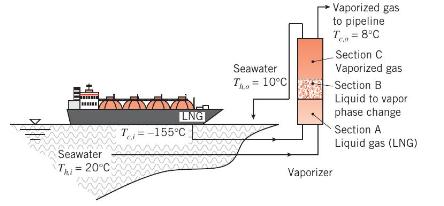Work Problem 11.53 for the situation where the seawater is introduced to the top of the vaporizer,
Question:
Work Problem 11.53 for the situation where the seawater is introduced to the top of the vaporizer, resulting in counterflowing natural gas and seawater.
Data From Problem 11.53:-
A liquefied natural gas (LNG) regasification facility utilizes a vertical heat exchanger or vaporizer that consists of a shell with a single-pass tube bundle used to convert the fuel to its vapor form for subsequent delivery through a land-based pipeline. Pressurized LNG is off-loaded from an oceangoing tanker to the bottom of the vaporizer at \(T_{c, i}=-155^{\circ} \mathrm{C}\) and \(\dot{m}_{\mathrm{LNG}}=150 \mathrm{~kg} / \mathrm{s}\) and flows through the shell. The pressurized LNG has a vaporization temperature of \(T_{f}=-75^{\circ} \mathrm{C}\) and specific heat \(c_{p, l}=4200 \mathrm{~J} / \mathrm{kg} \cdot \mathrm{K}\). The specific heat of the vaporized natural gas is \(c_{p, v}=2210 \mathrm{~J} / \mathrm{kg} \cdot \mathrm{K}\) while the gas has a latent heat of vaporization of \(h_{f g}=575 \mathrm{~kJ} / \mathrm{kg}\). The LNG is heated with seawater flowing through the tubes, also introduced at the bottom of the vaporizer, that is available at \(T_{h, i}=20^{\circ} \mathrm{C}\) with a specific heat of \(c_{p, \mathrm{SW}}=3985 \mathrm{~J} / \mathrm{kg} \cdot \mathrm{K}\). If the gas is to leave the vaporizer at \(T_{c, o}=8^{\circ} \mathrm{C}\) and the seawater is to exit the device at \(T_{h, o}=10^{\circ} \mathrm{C}\), determine the required vaporizer heat transfer area.

Step by Step Answer:

Fundamentals Of Heat And Mass Transfer
ISBN: 9781119220442
8th Edition
Authors: Theodore L. Bergman, Adrienne S. Lavine





